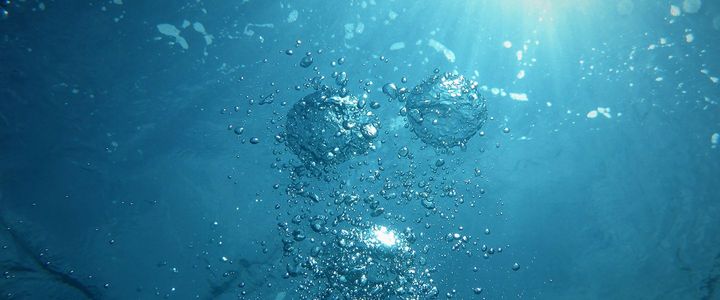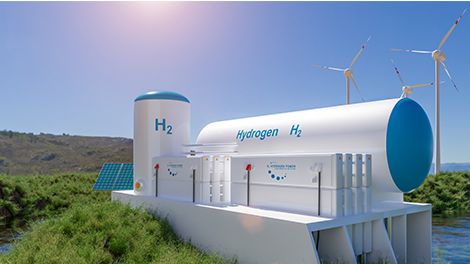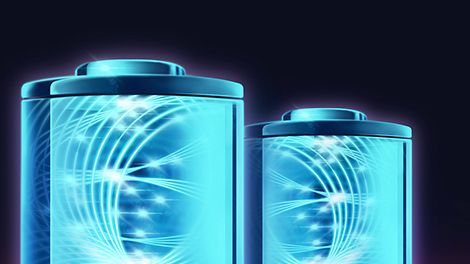Producing hydrogen with electrolysis
„Electrolysis" refers to the cracking of a chemical compound using electric current. Electrolysis thus separates the substances contained in the compound from each other. Electrolysis is carried out in an electrolyzer. Electrolysis requires two electrodes (anode and cathode), a direct current source and an electrolyte (e.g. pure water or alkaline compounds), i.e. an electrically conductive liquid. Since hydrogen (H2) only exists in bound form, it must first be dissolved from this compound. Electrolysis is therefore necessary for the production of hydrogen: Here, two hydrogen molecules (2H2) and one oxygen molecule (O2) are extracted from two water molecules (2H2O) each. This form of electrolysis is also called "water electrolysis".
Hydrogen is a topic with many facets - from production, transport and storage to use. With our expertise, know-how and many years of experience, we are an independent partner for safety and security by being able to test, inspect and certify various aspects of hydrogen technology.
Hydrogen: electrolysis processes and their sustainability
Three different processes can be used in the electrolysis of water to produce hydrogen: AEL electrolysis, PEM electrolysis and HTE electrolysis. The processes for water electrolysis and the corresponding plants differ in aspects such as the technologies and materials used, but also in terms of current density and energy efficiency. The latter vary between approximately 60 and 85 %. However, all methods share the basic principle of producing hydrogen through the electrolysis of hydrogen-containing compounds.
The answer to the question of whether hydrogen can ultimately be produced in an environmentally friendly way through the electrolysis of water depends on the electricity used. If it comes from renewable energies, the hydrogen produced by electrolysis is also considered free of carbon dioxide (CO2) and sustainable. In this case it is green hydrogen. So the production of green hydrogen also benefits from the expansion of renewable energies. The cheaper it is to produce sustainable electricity, the cheaper it is to produce green hydrogen using water electrolysis. We can distinguish between the following processes for producing hydrogen by electrolysis:
AEL electrolysis (alkaline electrolyzer)
Alkaline electrolyzers are used on an industrial scale worldwide because they are the most tried and tested, work with comparatively inexpensive materials and are characterized by high long-term stability. They use a potassium hydroxide solution (KOH) with a concentration of 20 to 40 % as electrolyte. Under a DC voltage of at least 1.5 volts, hydrogen is formed at the cathode (positively charged) and oxygen at the anode (negatively charged). Nickel-based electrodes and titanium electrodes coated with ruthenium oxide or iridium oxide serve as electrodes.
In AEL electrolysis, the efficiency is limited: In alkaline electrolyzers, the anode and cathode are separated by a porous, semi-permeable Zirfon membrane. This can only withstand limited pressure and can only be operated at low current densities (maximum 600 milliamperes per square centimetre of membrane surface). In AEL electrolysis, the hydrogen must therefore subsequently be compressed with a high energy input so that it can be stored and then forwarded.
HTE electrolysis (high temperature or steam electrolyzer)
Depending on the design, a high-temperature elektrolyzer (HTE) operates in the temperature spectrum between 100 °C and approx. 900 °C , with the temperature efficiency increasing accordingly. Compared to AEL and PEM electrolyzers, it does not require any precious metal components. In HTE electrolysis for hydrogen production, the water vapour meets a solid oxide electrolysis cell. In this cell, the water molecules are split via nickel-cermet steam-hydrogen electrodes and mixed oxides of lanthanum, strontium and cobalt-oxygen electrodes.
HTE electrolysis ensures high efficiency: with efficiencies of up to 90 %, high-temperature electrolysis is considered a particularly efficient way to produce hydrogen on an industrial scale. Its advantages lie in the area of energy-intensive sectors, such as the steel industry, where large amounts of waste heat are available and can be used in high-temperature electrolysis. Currently, HTE electrolysis is still in the pilot phase.
PEM electrolysis (acid electrolyzer)
In the PEM electrolyzer for the production of hydrogen, a solid polymer electrolyte is used instead of a liquid electrolyte. This is also called a "proton exchange membrane", hence the abbreviation "PEM". Distilled water or drinking water flows around the membrane. The aggressive, acidic environment in PEM electrolysis is very demanding on the materials. Therefore, the polymer membrane is equipped with a porous platinum-coated carbon electrode on the cathode side. On the anode side, it usually has a ruthenium or iridium oxide coating.
PEM electrolysis is characterized by high efficiency: With 2,000 milliamperes per square centimetre of membrane surface, the solid, semi-permeable polymer membrane for PEM electrolysis allows a current density three times higher than the Zirfon membrane in AEL plants. PEM electrolysis achieves an efficiency of 60 to 70 %, depending on the application. In addition, it can withstand greater load fluctuations.
Since PEM electrolyzers can be operated at high pressure, they also reduce the energy required for subsequent hydrogen compression for storage and transport. The higher efficiency makes it possible to produce the same amount of hydrogen with smaller electrolyzers as with larger AEL units. Replacing the expensive catalyst platinum with molybdenum sulphite also reduces investment costs in production. In addition, the comparatively new PEM electrolysis still has a lot of potential for further technical development.
Electrolysis in Germany: Status quo in hydrogen production
Currently, the chemical industry in Germany produces around three terawatt-hours (TWh) of hydrogen every year through water electrolysis. To put this into perspective: in 2020, Germany's gross electricity consumption was around 545 TWh. The biggest challenge at present is that a lot of energy has to be expended for the electrolysis of water to produce hydrogen. However, a lot is being done in this country in terms of electrolysis: with the PEM hydrogen electrolysis plant at Shell's Rheinland refinery (Wesseling), the world's largest PEM hydrogen electrolysis plant is located in Germany.
The German government's National Hydrogen Strategy, published in 2020, contains an action plan that describes the steps necessary for the strategy's success. It states that the possibilities for new types of business models and cooperations between electrolyzer operators and electricity and gas network operators must be analyzed. This will be done under consideration of regulatory unbundling. In addition, one or two pilot projects to strengthen the hydrogen market in Germany are announced, in which approaches with high potential will be tested - under the condition that a significant relief of the electricity and gas networks at reasonable prices is given and that there is no violation of competitive neutrality. "Competitive neutrality" means that the state has no advantage as a market participant. It is also being examined whether the framework conditions need to be adapted in order to promote corresponding concepts around electrolysis and hydrogen.



